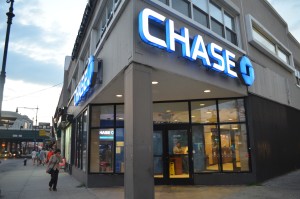JPMorgan Chase in January hinted it was interested in launching a retail presence in Boston, as part of a broader initiative to put up 400 new retail branches nationwide over the next five years.
Less than three months later, the banking behemoth received permission from state regulators to open two branches in Boston and one in Brookline. Two months after that, JPMorgan applied to open branches in Dedham and Watertown.
The speed in which the company has moved to set up its retail branches is enough to scare any small financial institution.
But community bankers strongly believe – or at the very least hope – that the long-running relationships they have spent decades seeding and watering will be able to stave off the competition and thrust the heat onto other larger banks in the area like Bank of America.
“If they think they can come into the city and duplicate what community banks have been doing – it has taken a long time to develop the culture of community banking – we will have to see,” Richard Gavegnano, president, CEO and chairman of the parent company of East Boston Savings Bank, told Banker & Tradesman. “The proof will be in the pudding.”
Not all big banks that come into heavily banked Boston thrive. Citibank tried to enter the Boston market in 2007, opening more than 30 de novo branches over the years. But by 2015, after failing to pick up a significant amount of market share, all of those branches had been sold or closed.
JPMorgan is likely focused on winning market share from the larger institutions because the bank needs a massive deposit base to fund its commercial operations, surmised Bob Meara, a senior analyst in the banking group at the Boston-based firm Celent.
The bank did something similar when it put up retail branches in Florida, said Meara, targeting the state’s older population, which is more branch friendly and less likely to do mobile banking.
“There is comparatively little business to be had from community financial institutions,” Meara said. “If you are going to compete for that [older] demographic and roughly half of the U.S. banking market, it won’t just be with mobile app; you are going to need retail branch footprint.”

Bram Berkowitz
Community Banking Confidence
Gavegnano said he is very confident in EBSB’s branch-heavy model – and if there’s a bank that knows how to make the branch work, it’s EBSB.
At the turn of the century, EBSB had less than 10 branches. Today, it has 35, nine of which have come in the last five years, according to the FDIC. The bank is in the midst of opening six more new branches this year alone.
All of these new branches have come at a time when the branch is on the decline overall and have helped EBSB grow by more than $3 billion in total assets over the last five years.
“We’ve been doing the opposite of what everyone else has been doing over last 10 years. That has enabled us to capture a lot of market share,” Gavegnano said. “In the neighborhoods we serve, there are a lot of people that like face-to-face interactions, hand-holding and to know who they are dealing with.”
Dedham Institute for Savings holds the top deposit share in Dedham – where JPMorgan is putting a branch – and its president and CEO agrees wholeheartedly with Gavegnano.
“We are so relationship-driven,” Peter Brown said. “Some of the customers they are trying to attract wouldn’t necessarily jump ship from a 187-year-old community bank.”
Still, Brown acknowledges that Bank of America has been effective in the Dedham market. What it will come down to is who JPMorgan staffs their branches with and what kind of technology they bring to the table, he said.
What Community Banks Must Do
Balancing a strong branch presence while improving their digital offerings will be key for community banks, said Meara.
Small banks are still superior in customer service and loyalty.
Forty-four percent of community bank or credit union customers surveyed were likely to recommend their bank to a friend, compared to 27 percent of larger bank customers, according to a report that Meara recently authored for Celent.
The digital side is where community institutions were more vulnerable.
Nearly half of the 50 largest banks in North America, Europe and Australia allow customers to open the majority of their personal banking products and lending applications digitally, according to a recent study from the digital specialization company Avoka. At the same time, the report also showed that most of these banks’ prominent personal banking products scored above average for ease of use.
Meara said most community banks focus on replicating digital transactional offerings that large banks offer, such as mobile deposits and fingerprint authentication. But they need to think about how customers are communicating with their friends and family online through outlets such as chat apps or Facetime and try to replicate that engagement, he said.
“The best thing community institutions can do in the short-term is to continue to know and serve their clients well with superior in-branch experiences,” said Meara. “Their call to action is to up their digital game.”




 |
| 
